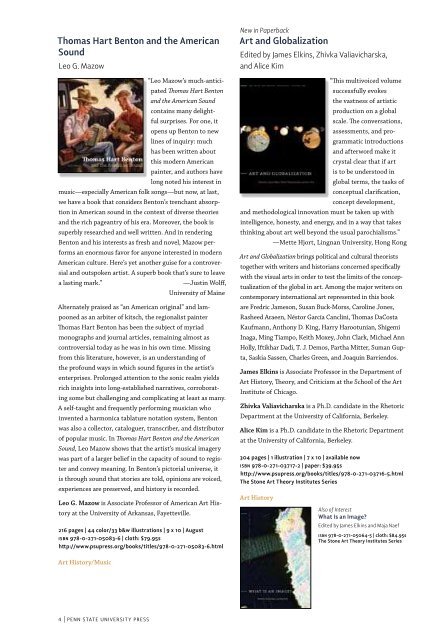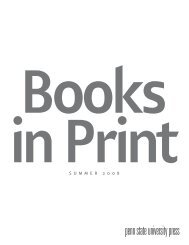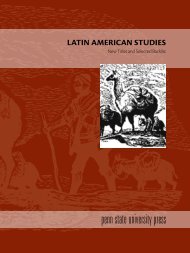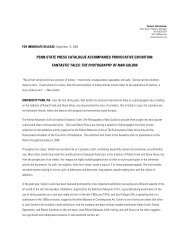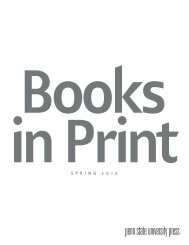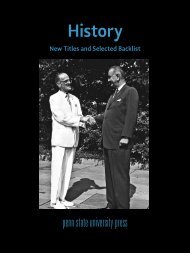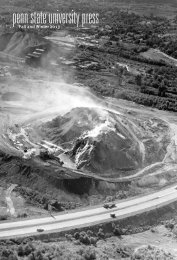journals - Pennsylvania State University Press
journals - Pennsylvania State University Press
journals - Pennsylvania State University Press
You also want an ePaper? Increase the reach of your titles
YUMPU automatically turns print PDFs into web optimized ePapers that Google loves.
Thomas Hart Benton and the American<br />
Sound<br />
Leo G. Mazow<br />
“Leo Mazow’s much-anticipated<br />
Thomas Hart Benton<br />
and the American Sound<br />
contains many delightful<br />
surprises. For one, it<br />
opens up Benton to new<br />
lines of inquiry: much<br />
has been written about<br />
this modern American<br />
painter, and authors have<br />
long noted his interest in<br />
music—especially American folk songs—but now, at last,<br />
we have a book that considers Benton’s trenchant absorption<br />
in American sound in the context of diverse theories<br />
and the rich pageantry of his era. Moreover, the book is<br />
superbly researched and well written. And in rendering<br />
Benton and his interests as fresh and novel, Mazow performs<br />
an enormous favor for anyone interested in modern<br />
American culture. Here’s yet another guise for a controversial<br />
and outspoken artist. A superb book that’s sure to leave<br />
a lasting mark.” —Justin Wolff,<br />
<strong>University</strong> of Maine<br />
Alternately praised as “an American original” and lampooned<br />
as an arbiter of kitsch, the regionalist painter<br />
Thomas Hart Benton has been the subject of myriad<br />
monographs and journal articles, remaining almost as<br />
controversial today as he was in his own time. Missing<br />
from this literature, however, is an understanding of<br />
the profound ways in which sound figures in the artist’s<br />
enterprises. Prolonged attention to the sonic realm yields<br />
rich insights into long-established narratives, corroborating<br />
some but challenging and complicating at least as many.<br />
A self-taught and frequently performing musician who<br />
invented a harmonica tablature notation system, Benton<br />
was also a collector, cataloguer, transcriber, and distributor<br />
of popular music. In Thomas Hart Benton and the American<br />
Sound, Leo Mazow shows that the artist’s musical imagery<br />
was part of a larger belief in the capacity of sound to register<br />
and convey meaning. In Benton’s pictorial universe, it<br />
is through sound that stories are told, opinions are voiced,<br />
experiences are preserved, and history is recorded.<br />
Leo G. Mazow is Associate Professor of American Art History<br />
at the <strong>University</strong> of Arkansas, Fayetteville.<br />
216 pages | 44 color/33 b&w illustrations | 9 x 10 | August<br />
isbn 978-0-271-05083-6 | cloth: $79.95s<br />
http://www.psupress.org/books/titles/978-0-271-05083-6.html<br />
Art History/Music<br />
New in Paperback<br />
Art and Globalization<br />
Edited by James Elkins, Zhivka Valiavicharska,<br />
and Alice Kim<br />
“This multivoiced volume<br />
successfully evokes<br />
the vastness of artistic<br />
production on a global<br />
scale. The conversations,<br />
assessments, and pro-<br />
grammatic introductions<br />
and afterword make it<br />
crystal clear that if art<br />
is to be understood in<br />
global terms, the tasks of<br />
conceptual clarification,<br />
concept development,<br />
and methodological innovation must be taken up with<br />
intelligence, honesty, and energy, and in a way that takes<br />
thinking about art well beyond the usual parochialisms.”<br />
—Mette Hjort, Lingnan <strong>University</strong>, Hong Kong<br />
Art and Globalization brings political and cultural theorists<br />
together with writers and historians concerned specifically<br />
with the visual arts in order to test the limits of the conceptualization<br />
of the global in art. Among the major writers on<br />
contemporary international art represented in this book<br />
are Fredric Jameson, Susan Buck-Morss, Caroline Jones,<br />
Rasheed Araeen, Néstor García Canclini, Thomas DaCosta<br />
Kaufmann, Anthony D. King, Harry Harootunian, Shigemi<br />
Inaga, Ming Tiampo, Keith Moxey, John Clark, Michael Ann<br />
Holly, Iftikhar Dadi, T. J. Demos, Partha Mitter, Suman Gupta,<br />
Saskia Sassen, Charles Green, and Joaquín Barriendos.<br />
James Elkins is Associate Professor in the Department of<br />
Art History, Theory, and Criticism at the School of the Art<br />
Institute of Chicago.<br />
Zhivka Valiavicharska is a Ph.D. candidate in the Rhetoric<br />
Department at the <strong>University</strong> of California, Berkeley.<br />
Alice Kim is a Ph.D. candidate in the Rhetoric Department<br />
at the <strong>University</strong> of California, Berkeley.<br />
304 pages | 1 illustration | 7 x 10 | available now<br />
isbn 978-0-271-03717-2 | paper: $39.95s<br />
http://www.psupress.org/books/titles/978-0-271-03716-5.html<br />
The Stone Art Theory Institutes Series<br />
Art History<br />
Also of Interest<br />
What Is an Image?<br />
Edited by James Elkins and Maja Naef<br />
isbn 978-0-271-05064-5 | cloth: $84.95s<br />
The Stone Art Theory Institutes Series<br />
“An eloquent history of the<br />
distinguished Princeton campus.<br />
Thank you, Barksdale Maynard.”<br />
—Robert Venturi<br />
“Anyone interested in universities,<br />
architecture, and social history will want<br />
to read this fascinating book.”<br />
Also of Interest<br />
Liberalizing the Mind: Two<br />
Centuries of Liberal Education at<br />
Franklin & Marshall College<br />
Sally F. Griffith<br />
isbn 978-0-271-03723-3 | cloth: $64.95s<br />
—Neil L. Rudenstine,<br />
Harvard <strong>University</strong><br />
Princeton<br />
America’s Campus<br />
W. Barksdale Maynard<br />
Founded in 1746, Princeton is the fourth oldest university<br />
in the country. It has been called “a national treasure” and<br />
is considered by many to be the loveliest campus in America.<br />
The very word “campus” debuted there in the eighteenth<br />
century, and over time, Princeton’s has ceaselessly evolved,<br />
passing through a series of distinct identities. Architectural<br />
critics have lavishly praised it, and careful stewardship by<br />
administrators and architects has preserved its appeal from<br />
generation to generation. Thousands of alumni return every<br />
year to march in the gaudy P-rade, which twists among the<br />
buildings in a veritable tour of campus history, from Nassau<br />
Hall (1756) to the twenty-first century’s Bloomberg Hall. And<br />
yet, if one wants to know more—to go deeper than the beautiful<br />
surface and explore the history of these buildings or the<br />
complex development of the campus—it can be surprisingly<br />
hard to do. Although Princeton resembles an outdoor museum,<br />
explanatory markers are few, written sources are out<br />
of print and scattered, and sophomore tour guides cheerfully<br />
mix fact and myth. No plaques can help the curious visitor<br />
who may want to follow in the footsteps of James Madison,<br />
Aaron Burr, James McCosh, Albert Einstein, John Foster<br />
Dulles, Bill Bradley, or Michelle Obama, and the stories of the<br />
buildings themselves are known to few. Princeton: America’s<br />
Campus offers a way in. Neither a straightforward architectural<br />
history nor a simple guidebook, it weaves social history and<br />
the built fabric into a biography of a great American place.<br />
To create this work, Barksdale Maynard undertook an<br />
ambitious series of interviews with major architects active<br />
at Princeton over the past forty years, including Robert<br />
Venturi, Denise Scott Brown, Charles Gwathmey, Michael<br />
Graves, Tod Williams, Hugh Hardy, Perry Morgan, Rodolfo<br />
Machado, Henry Cobb, Frances Halsband, Demetri Porphyrios,<br />
Harold Fredenburgh, Alan Chimacoff, Robert A. M.<br />
Stern, and Rafael Vinoly. He also interviewed educational<br />
leaders, including deans at Princeton, MIT, Cooper Union,<br />
and Yale, plus university presidents Goheen and Bowen of<br />
Princeton, Gutmann of Penn, and Rudenstine of Harvard.<br />
The book is not just a guide and a history; it is also an<br />
archive of the living recollections of the people who built<br />
Princeton’s majestic campus.<br />
W. Barksdale Maynard is the author of five books on<br />
American history, architecture, and landscape. Trained as<br />
an architectural historian, he has taught at Johns Hopkins<br />
and Princeton.<br />
288 pages | 150 illustrations/3 maps | 8 x 10 | June<br />
isbn 978-0-271-05085-0 | cloth: $44.95s<br />
isbn 978-0-271-05086-7 | paper: $19.95s<br />
http://www.psupress.org/books/titles/978-0-271-05085-0.html<br />
Architecture/Education/History<br />
4 | penn state university press www.psupress.org | 5


